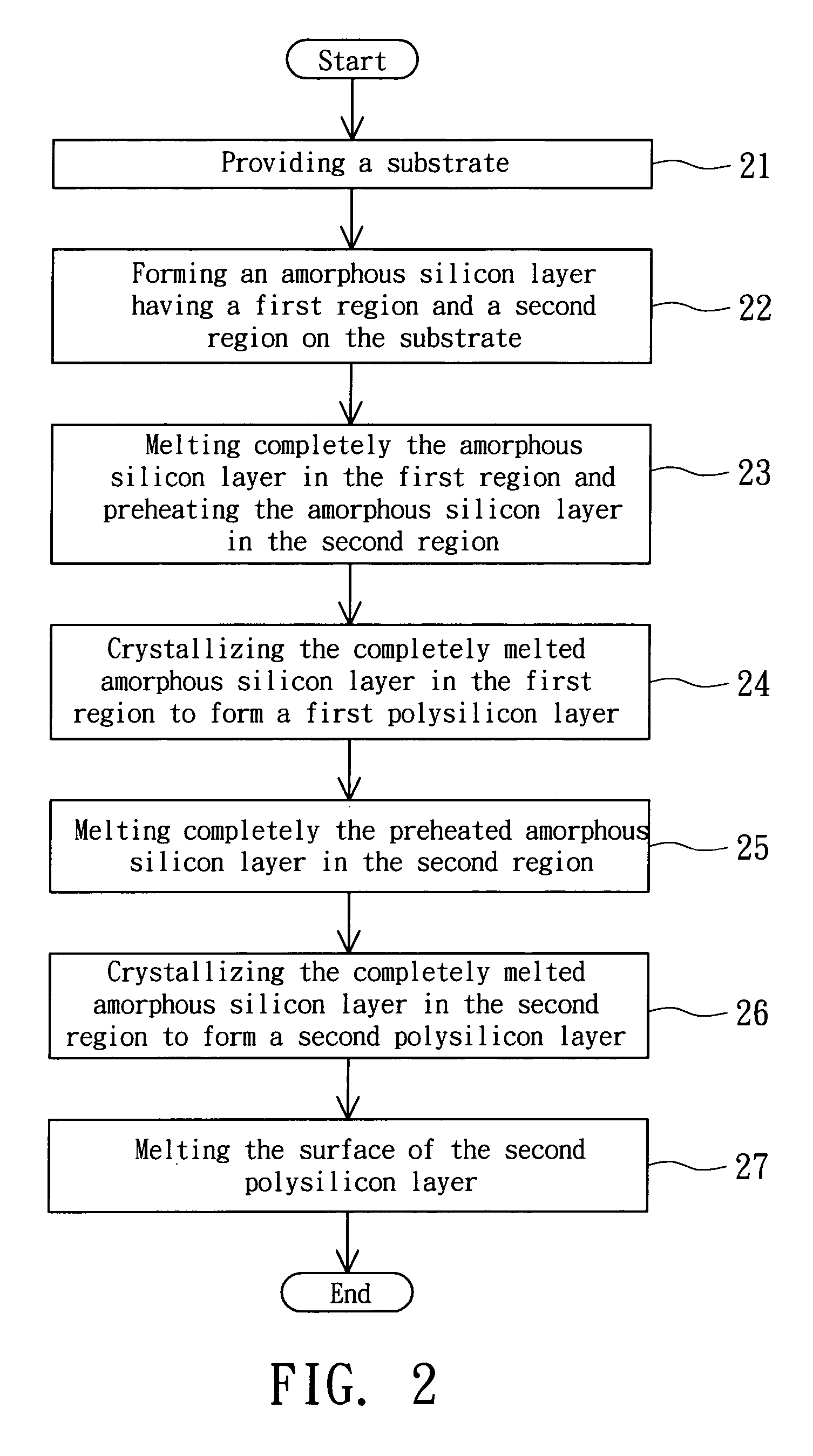Method of manufacturing a polysilicon layer and a mask used therein
a polysilicon and manufacturing method technology, applied in the field of manufacturing a polysilicon layer, can solve the problems of poor utilization rate of laser beam, additional manufacturing steps and manufacturing costs, etc., and achieve the effects of prolonging the melting time of silicon, reducing the usage of laser beam, and prolonging the maintenance period of laser beam optical modules
- Summary
- Abstract
- Description
- Claims
- Application Information
AI Technical Summary
Benefits of technology
Problems solved by technology
Method used
Image
Examples
first embodiment
[0017]Referring to FIGS. 2 and 3A˜3E, wherein FIG. 2 is a flowchart diagram of a method of manufacturing a polysilicon layer according to a first embodiment of the invention, while FIGS. 3A˜3E are flowchart diagrams of a method of manufacturing a polysilicon layer according to a first embodiment of the invention. Firstly, the method begins at step 21: a substrate 21 is provided as shown in FIG. 3A. Next, proceed to the step 22 of FIG. 2: an amorphous silicon layer 32 having a first region 32a and a second region 32b is formed on the substrate 31 as shown in FIG. 3B. After that, proceed to step 23: the amorphous silicon layer 32 in the first region 32a is completely melted and the amorphous silicon layer 32 in the second region 32b is preheated as shown in FIG. 3C. Then, proceed to step 24: the completely melted amorphous silicon layer in first region 32a is crystallized to form a first polysilicon layer 33a as shown in FIG. 3D.
[0018]To achieve the object of completely melting the am...
second embodiment
[0024]Referring to FIG. 5, a top view of a mask for the laser beam to preheat and melt an amorphous silicon layer according to a second embodiment of the invention is shown. In FIG. 5, a mask 55 is used for a laser beam to preheat and melt an amorphous silicon layer disposed on a substrate. The amorphous silicon layer has a first region and a second region, while the mask 55 is moved relatively to the substrate. The technology of forming an amorphous silicon layer on the substrate and moving a mask relatively to the substrate are disclosed in the first embodiment and is not repeated in the present embodiment again. The mask 55 comprises a mask body 55b, a non-transparent region 55a, a first mask pattern 56, a second mask pattern 57 and a semi-transparent region 55d. The non-transparent region 55a is formed on the mask body 55b. The first mask pattern 56, the second mask pattern 57 and the semi-transparent region 55d are mutually separated and formed on the mask body 55b. The second ...
PUM
| Property | Measurement | Unit |
|---|---|---|
| thickness | aaaaa | aaaaa |
| semi-transparent | aaaaa | aaaaa |
| transparent | aaaaa | aaaaa |
Abstract
Description
Claims
Application Information
 Login to View More
Login to View More - R&D
- Intellectual Property
- Life Sciences
- Materials
- Tech Scout
- Unparalleled Data Quality
- Higher Quality Content
- 60% Fewer Hallucinations
Browse by: Latest US Patents, China's latest patents, Technical Efficacy Thesaurus, Application Domain, Technology Topic, Popular Technical Reports.
© 2025 PatSnap. All rights reserved.Legal|Privacy policy|Modern Slavery Act Transparency Statement|Sitemap|About US| Contact US: help@patsnap.com



